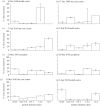Concentrations and size distributions of airborne influenza A viruses measured indoors at a health centre, a day-care centre and on aeroplanes
- PMID: 21300628
- PMCID: PMC3119883
- DOI: 10.1098/rsif.2010.0686
Concentrations and size distributions of airborne influenza A viruses measured indoors at a health centre, a day-care centre and on aeroplanes
Abstract
The relative importance of the aerosol transmission route for influenza remains contentious. To determine the potential for influenza to spread via the aerosol route, we measured the size distribution of airborne influenza A viruses. We collected size-segregated aerosol samples during the 2009-2010 flu season in a health centre, a day-care facility and onboard aeroplanes. Filter extracts were analysed using quantitative reverse transcriptase polymerase chain reaction. Half of the 16 samples were positive, and their total virus concentrations ranged from 5800 to 37,000 genome copies m(-3). On average, 64 per cent of the viral genome copies were associated with fine particles smaller than 2.5 µm, which can remain suspended for hours. Modelling of virus concentrations indoors suggested a source strength of 1.6±1.2×10(5) genome copies m(-3) air h(-1) and a deposition flux onto surfaces of 13±7 genome copies m(-2) h(-1) by Brownian motion. Over 1 hour, the inhalation dose was estimated to be 30±18 median tissue culture infectious dose (TCID50), adequate to induce infection. These results provide quantitative support for the idea that the aerosol route could be an important mode of influenza transmission.
Figures

Similar articles
-
Measurements of airborne influenza virus in aerosol particles from human coughs.PLoS One. 2010 Nov 30;5(11):e15100. doi: 10.1371/journal.pone.0015100. PLoS One. 2010. PMID: 21152051 Free PMC article.
-
Virus shedding and environmental deposition of novel A (H1N1) pandemic influenza virus: interim findings.Health Technol Assess. 2010 Oct;14(46):237-354. doi: 10.3310/hta14460-04. Health Technol Assess. 2010. PMID: 20923613
-
Update: Influenza A (H3N2)v transmission and guidelines - five states, 2011.MMWR Morb Mortal Wkly Rep. 2012 Jan 6;60(51-52):1741-4. MMWR Morb Mortal Wkly Rep. 2012. PMID: 22217624
-
Airborne Influenza A Is Detected in the Personal Breathing Zone of Swine Veterinarians.PLoS One. 2016 Feb 11;11(2):e0149083. doi: 10.1371/journal.pone.0149083. eCollection 2016. PLoS One. 2016. PMID: 26867129 Free PMC article.
-
Exposure to influenza virus aerosols during routine patient care.J Infect Dis. 2013 Apr;207(7):1037-46. doi: 10.1093/infdis/jis773. Epub 2013 Jan 30. J Infect Dis. 2013. PMID: 23372182
Cited by
-
Analysis on the risk of respiratory virus transmission by air conditioning system operation based on experimental evidence.Environ Sci Pollut Res Int. 2021 Oct;28(40):56376-56391. doi: 10.1007/s11356-021-14495-0. Epub 2021 May 29. Environ Sci Pollut Res Int. 2021. PMID: 34053044 Free PMC article.
-
A comprehensive breath plume model for disease transmission via expiratory aerosols.PLoS One. 2012;7(5):e37088. doi: 10.1371/journal.pone.0037088. Epub 2012 May 15. PLoS One. 2012. PMID: 22615902 Free PMC article.
-
Close encounters of the infectious kind: methods to measure social mixing behaviour.Epidemiol Infect. 2012 Dec;140(12):2117-30. doi: 10.1017/S0950268812000842. Epub 2012 Jun 12. Epidemiol Infect. 2012. PMID: 22687447 Free PMC article. Review.
-
Design and Validation with Influenza A Virus of an Aerosol Transmission Chamber for Ferrets.Int J Environ Res Public Health. 2019 Feb 19;16(4):609. doi: 10.3390/ijerph16040609. Int J Environ Res Public Health. 2019. PMID: 30791478 Free PMC article.
-
Swine-Origin H1 Influenza Viruses Isolated from Humans Exhibit Sustained Infectivity in an Aerosol State.Appl Environ Microbiol. 2019 May 2;85(10):e00210-19. doi: 10.1128/AEM.00210-19. Print 2019 May 15. Appl Environ Microbiol. 2019. PMID: 30877121 Free PMC article.
References
-
- Tellier R. 2009. Aerosol transmission of influenza A virus: a review of new studies. J. R. Soc. Interface 6, S783–S79010.1098/rsif.2009.0302.focus (doi:10.1098/rsif.2009.0302.focus) - DOI - DOI - PMC - PubMed
-
- Brankston G., Gitterman L., Hirji Z., Lemieux C., Gardam M. 2007. Transmission of influenza A in human beings. Lancet Infect. Dis. 7, 257–26510.1016/S1473-3099(07)70029-4 (doi:10.1016/S1473-3099(07)70029-4) - DOI - DOI - PubMed
-
- Fabian P., Mcdevitt J. J., Lee W.-M., Houseman E. A., Milton D. K. 2009. An optimized method to detect influenza virus and human rhinovirus from exhaled breath and the airborne environment. J. Environ. Monit. 11, 314–31710.1039/b813520g (doi:10.1039/b813520g) - DOI - DOI - PMC - PubMed
-
- Fabian P., Mcdevitt J. J., Houseman E. A., Milton D. K. 2009. Airborne influenza virus detection with four aerosol samplers using molecular and infectivity assays: considerations for a new infectious virus aerosol sampler. Indoor Air 19, 433–44110.1111/j.1600-0668.2009.00609.x (doi:10.1111/j.1600-0668.2009.00609.x) - DOI - DOI - PMC - PubMed
Publication types
MeSH terms
Substances
LinkOut - more resources
Full Text Sources
Other Literature Sources
Medical

